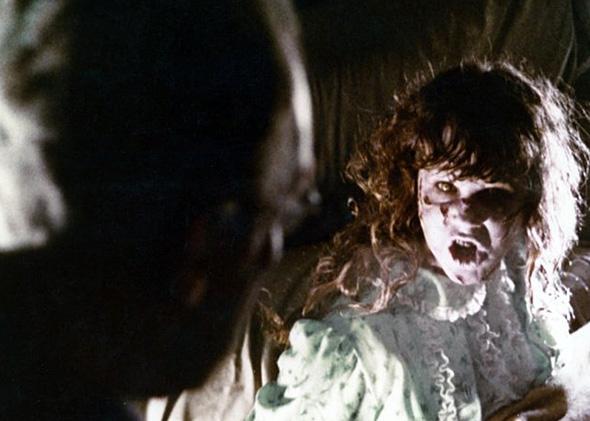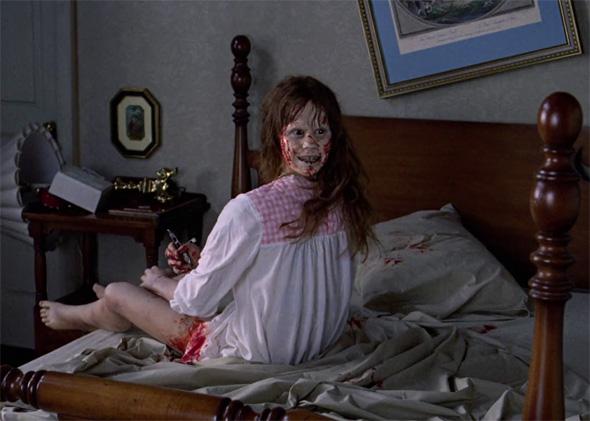There’s no reason it should’ve taken me three tries to get through The Exorcist. I like horror, and I don’t fret about Satanism—at least not consciously. But when I tried to read William Peter Blatty’s novel when I was 15 years old, I abandoned it about 100 pages in, too shaken to go on. I then avoided William Friedkin’s 1973 movie until the extended “version you never saw” was released in theaters in fall 2000, but about an hour into that, I started to feel mildly panicked, and left the theater. When I finally watched the revised Exorcist on DVD a year later, I did so during the daytime, with bright lights on and curtains open. All the while, I felt like I was doing something I shouldn’t—as though at any moment, the ground was going to open up and I was going to be consumed by the fires of hell.
I’d like to blame this feeling on growing up in the South, surrounded by fundamentalists, except that the devil-fearing churchgoers I knew as a kid were wildly pro-Exorcist. They were in accord with Father Eugene Gallagher, a Georgetown University faculty member who helped Blatty research cases of real-life demonic possession, and who registers his opinion about the film in old video interviews included on the new Blu-ray special edition of The Exorcist. Gallagher has a few quibbles with the way Blatty and Friedkin turned what he considers to be a subtle, internal phenomenon into a gross visual spectacle, but he’s fairly forgiving of the vulgarity and blasphemy in the movie, calling it a necessary part of depicting evil in action. Because it’s “true,” it’s OK.

Linda Blair in The Exorcist.
Courtesy Warner Bros.
I’ve long been amazed by what people with strong political or religious convictions will justify—or rebuke—when it comes to entertainment. I was working at a Blockbuster Video in a Nashville suburb during the summer when Jurassic Park came out, and one co-worker of mine refused to see it, because as a fundamentalist Christian, he found the whole idea of the movie silly, and perhaps even dangerous. “There’s no such thing as dinosaurs,” he told me. “I’m not going to stand for that crap.” Stuck behind the counter with him on an eight-hour shift, I just nodded, saying, “I can respect that.” After all, it was nothing I hadn’t heard before.
I’ve lived more or less my whole life in the South. I was born in Atlanta, raised in middle Tennessee, attended college back in Georgia, moved to northern Virginia as a newlywed, then settled in central Arkansas. I barely notice how strange the worldview can be down here, until I see it through the eyes of an outsider, amazed that I live in a dry county, and that even in the surrounding “wet” counties, retailers can’t sell booze on Sundays. I’ve sat in movie theaters where audiences cheered as characters murdered their enemies, but audibly “tsk-tsk”ed when those same characters said “goddamn.” My wife teaches at a public university, and frequently deals with students who attended seminars at their churches about how to resist college professors’ godless liberalism and evolution-pushing. My wife isn’t fazed by this at all. She grew up in Chattanooga, in a Southern Baptist family.
One weird kink of the Bible Belt, though, is its love/hate relationship with the occult. The torments of hell and the deceptions of Satan were never a big part of the theology I absorbed on Sundays, because my father was an Episcopal priest, and my mother is Presbyterian. When I stayed with my dad, church was a feel-good affair, all about personal healing and acoustic guitar sing-alongs; at my Presbyterian church, the minister was a scholarly Ph.D. with arthouse tastes, and his sermons tended to be a mix of biblical history lessons and thoughtful reviews of movies like The Gods Must Be Crazy and The Purple Rose Of Cairo. But on the other six days of the week? At school, especially? My Baptist and Church of Christ friends talked an awful lot about the devil.
Here’s what was off-limits, according to many of the people I grew up with: books about witchcraft, the writings of Anton LaVey, Ouija boards, New Age crystals, pentagrams, albums with backward masking, and the music of most heavy metal bands. I recall a worried older brother of one of my high school friends coming with the two of us to an Episcopal midnight Mass one Christmas Eve, then reporting back to their parents about the incense, the chanted liturgy, the candles, and the Latin—all highly dubious, in his opinion. Meanwhile, my first girlfriend was a devout Catholic who was beside herself when she saw me scrawl some non-Bible-related notes in the endpages of a free pocket version of the New Testament I’d gotten from a street-corner evangelist. And for a few months after college, I dated a contemporary-Christian singer who was aghast that I liked R.E.M., because she thought “Losing My Religion” was an evil song. According to all these people, I shouldn’t have been taking any chances with my immortal soul.
Yet here’s what was OK to enjoy, according to those same chums and acquaintances: The Omen. The Amityville Horror. Rosemary’s Baby. The Exorcist. These movies passed muster because they didn’t encourage people to dabble in the dark arts; they warned people. More to the point, they acknowledged the existence of God, the influence of Satan, and the truth of the Bible. They were visual representations of that old Louvin Brothers song: “Satan Is Real.”
On the Exorcist Blu-ray, Father Gallagher backs up those who want to see the film as reality-based. Describing the case that inspired Blatty—a 1949 exorcism that was better-documented than most—Gallagher says, “I don’t think it was anything unusual,” adding that the only thing special was that word of it leaked out to the newspapers. But Gallagher also resists the sensationalist view of possession, viewing it more as a medical condition that he wishes doctors took more seriously. “It’s a physical evil,” he says. “Like being mugged or raped.” And to Gallagher’s mind, priests should be more concerned with helping people heal spiritually, not physically.
At first, The Exorcist adopts Gallagher’s perspective. For much of its first hour, it’s part medical mystery and part social drama, following divorced, well-to-do actress Christine MacNeil (Ellen Burstyn) and her 12-year-old daughter Regan (Linda Blair), the latter of whom has been suffering unexplained spasms and Tourette’s-like eruptions of vulgarity. Chris puts Regan through painful medical procedures and tedious consultations with psychiatrists, before taking her problems to Father Damien Karras (Jason Miller), a priest suffering a crisis of faith. Some of the tensest moments in The Exorcist are the plainest: a scene where Chris rages into a phone (with Regan eavesdropping nearby) because her ex-husband didn’t call Regan on her birthday; or a scene where an addled Regan urinates on the carpet in front of her mother’s party guests. The Exorcist has flashes of horror in the early going, but they can all be read as emblematic of deeper issues: the anxiety of a single parent, a sweet young girl’s uncontrollable hormonal surges, and a general loss of purpose. When a green-faced Regan starts stabbing at her genitals with a crucifix, growling, “Let Jesus fuck you!” it isn’t just the possibility that there’s a demon inside her that’s disturbing, but rather that this charming little kid who was gushing about horses at the start of the movie is suddenly spewing the foulest, most sexualized blasphemies.

Linda Blair in The Exorcist, 1973.
Courtesy Warner Bros.
But let’s not kid ourselves: It’s also unsettling to hear those exact words (“Jesus” and “fuck”) in such close proximity, and to imagine a cross being used as a blood-soaked dildo. Father Gallagher gives it a pass, and my evangelical friends see it as in service to a more important message—like one of those Jack Chick tracts that lustily describes wanton youth in order to show how their sin leads directly to hell. But these same friends filled my head with so many notions of the taboo that first reading and then watching The Exorcist made me soul-sick. And I wasn’t even that religious.
The Exorcist resolves into a more straightforward good-vs.-evil clash in its last half-hour, as “What’s happening to Regan?” becomes “Can’t someone get that evil creature out of Regan?” In the end, Father Karras comes through, when he coaxes the demon to leave Regan and enter him, just before he kills himself. It’s a symbolic gesture: the doubt-filled, depressed Karras reconnecting with his spiritual beliefs in a very real way. But while it’s a powerful ending, it’s disappointingly blunt in comparison with what came before. What’s at the root of the MacNeils’ problems? The demon Pazuzu, now cast out. The end. Blame absolved.
The popularity of The Exorcist had the effect of popularizing exorcism itself—or at least that was what I heard around my school, where there were rumors of parents setting their children on fire because they thought their kids were possessed. Give some credit (or blame) for this to Blatty’s studiousness, and Friedkin’s gifts for documentarylike realism, which lend The Exorcist plausibility. Even though the demon in The Exorcist isn’t Satan—and isn’t even part of Christian mythology—the film does reinforce the idea that there are dark forces at work, requiring the righteous to remain vigilant. Dinosaurs are stupid, but beware Beelzebub.
I’ve identified this mentality with the South, because that’s the part of the world I know best (and love, honestly). But The Exorcist is set mostly in Washington, D.C., and is heavily Catholic. The Catholic strain of devil paranoia differs from Southern Baptist devil paranoia. (Wine-drinking vs. teetotaling may have something to do with that.) Some religious people see The Exorcist as merely metaphorical, capturing the spiritual rootlessness of the 1970s, while others see it as much more black-and-white, and love it for that. Down here, we’ve worked “wariness of Satanic influence” into a way of life far removed from the more academic approaches of the fictional Father Karras and the real Father Gallagher. Down here, we stew in it.
The kids I grew up with were so confident that Satan is “a defeated foe” that they could watch every exorcism movie and walk away feeling like informed soldiers in the war against perdition. The Exorcist has always messed with my head, though, because it depicts with uncanny matter-of-factness what so many of the people around me believe to be true. Their whispers in my ear still produce an involuntary response. The juju seeps into the brain, and convulses the body.
Click here to read more from the Dissolve.
